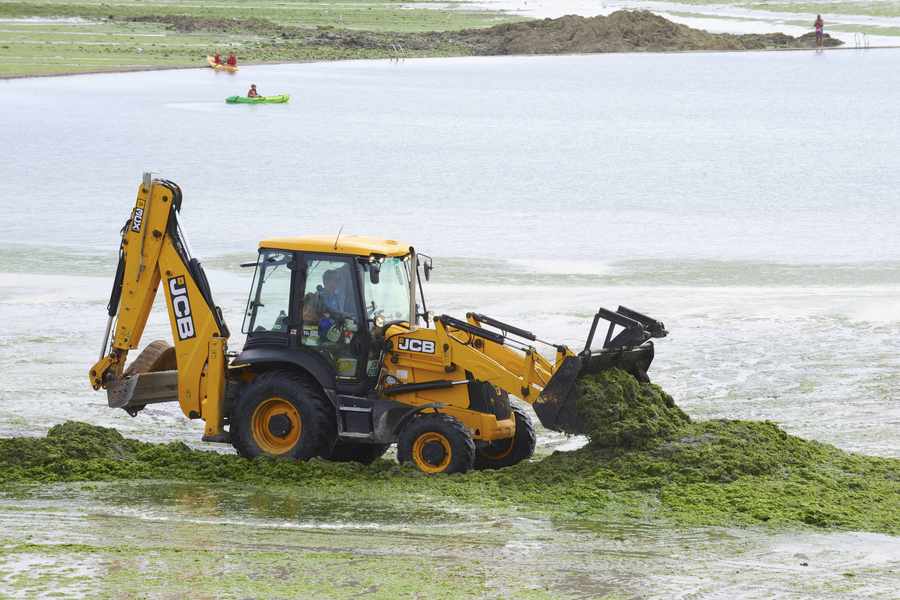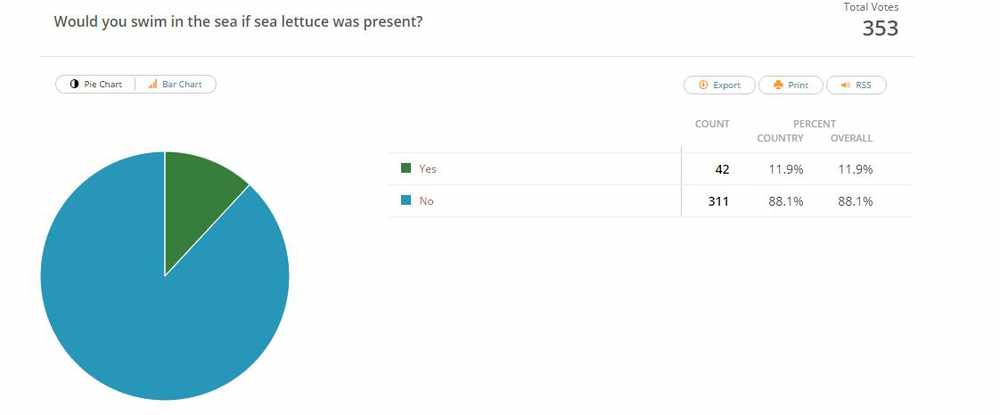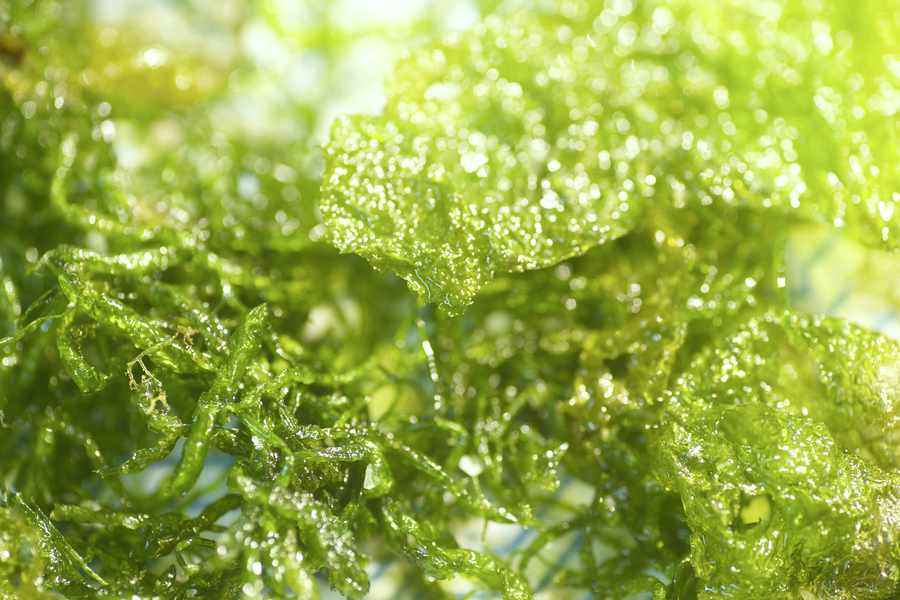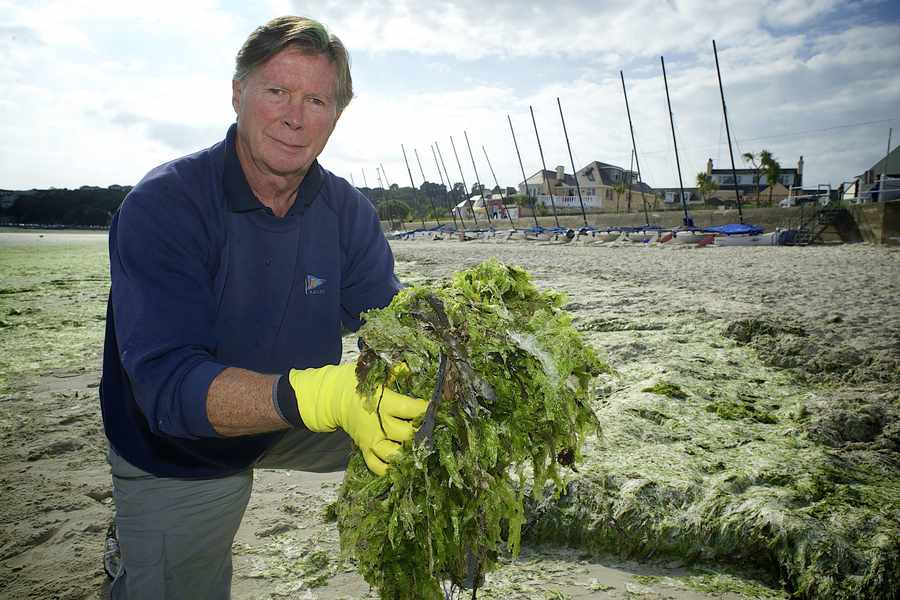- Environment Minister says nothing can be done to remove sea lettuce in St Aubin’s Bay this year
- He says that finding a long-term solution to the problem will be difficult
- See the results of two recent JEP Online polls below
- Would you cook with sea lettuce? check out these recipes below
NOTHING can be done to remove the huge build-up of sea lettuce in St Aubin’s Bay this year, and finding a long-term solution to the problem will be difficult, the Environment Minister admits.
Deputy Steve Luce recently met other senior politicians, including Transport Minister Eddie Noel and Economic Development Minister Lyndon Farnham, following complaints over the high levels of deposits of the slim, green seaweed.
Concerns have grown that the foot-deep piles of sea lettuce strewn across the beach are damaging local businesses, including sea-sports companies and beach cafés, and could harm the reputation of Jersey as a tourist destination.
But Deputy Luce has warned that he doubts there will be any resolution to the problem this summer, and believes that the only solution may be to deal with it earlier each year.
‘If we are being realistic, it’s too late this year to deal with it,’ he said.
‘The chances of restoring golden sands to St Aubin’s Bay are unlikely.
‘I think the problem needs to be tackled in April or May each year, because by the time you come into July or August, the conditions for sea lettuce to grow are too good.
‘Once you are into the summer and the conditions for growth improve, 100 tonnes of sea lettuce can quickly turn into thousands or tens of thousands of tonnes, so you have to get rid of it before it takes root.’
Jersey sportsman Gordon Burgis, who is involved in racing Hobie Cats – small open-top catamarans – in St Aubin’s Bay, believes that not enough is been done to get rid of the substance.
‘The weed has been getting into the rudders of the Hobie Cats, which affects their sailing ability,’ he said.
‘We were looking at holding a world championship racing event in Jersey, but this wouldn’t be possible under the current conditions.’

Diana Troy, the manager of La Frégate café on the Waterfront, said that the sea lettuce was a concern for her business.
‘It’s very unsightly for our customers and the smell is off-putting for those who are eating in our outside seating area,’ she said.
Deputy Luce stressed that the problem was nothing new and that previous measures to resolve it had met with limited success.
‘It’s something that has been going on for 30 to 40 years, and a lot of people have looked at the problem in the past,’ he said.
‘In the 80s, a lot of money was spent on trying to resolve the problem, but the measures proved to be ineffective.
‘And if the Transport Department were going to try to sort the problem out now, they could end up spending thousands on machinery to clear the sea lettuce, only to find that the wind direction changes and the conditions clear it naturally.’
The minister confirmed that it was believed that the flow of nitrates into St Aubin’s Bay from the Island’s streams was contributing to the sea lettuce problem – an issue that the States will address in plans which they intend to publish next year.
But he warned that tests had been carried out which cast doubt over whether reducing nitrate levels would have much impact on the sea lettuce problem.
‘We tested the nitrate levels out at sea and expected the levels to go down as we went further out, but they didn’t, they went up,’ he said.
‘Nitrates seem to be coming from outside waters into Jersey. It’s a global problem.
‘In Brittany they’ve had a lot of sea lettuce as well, and I believe the French have spent a lot of money trying to resolve the problem.’




The sea lettuce that turns St Aubin’s Bay green could be cultivated and used in fish food, toothpaste or canned goods, a former Environment Minister said in 2012
The radical suggestions came as then Environment Minister Deputy Rob Duhamel told an Environment Scrutiny panel what he thought should be done about the thousands of tons of sea lettuce that regularly cover the bay.
Deputy Duhamel told the panel that the Transport Department’s method of dealing with seaweed – getting heavy machinery to move it to the low-water mark – was not having any effect at all. He suggested that one option was for a seaweed-growing industry to be set up to cultivate the plant matter and sell it on.

‘Algae is a fantastic plant,’ he said. ‘It introduces a revenue-generating opportunity. The pharmaceutical industry uses alginates, they are present in canned foods and they have to be grown somewhere. They could be grown here.’
The Environment Minister added that seaweed was used by eastern countries to make fish food and he explained that he had already been contacted by an Islander who was interested in using the sea lettuce to make pellets that would feed beds of ormers.

Sea Lettuce Puree
- 500g sea lettuce
- 100ml double cream
- ½ garlic clove (infused in cream)
After washing thoroughly, blanch the sea lettuce in salted boiling water for 20-30 seconds, Remove and Immerse in ice water to refresh. Remove and pat dry between two clean cloths. Gently Heat the double Cream with the garlic to just below boiling point, strain and blend with the sea lettuce, season to taste.
Best served with local plaice or sass as a sauce or garnish.
Dried Sea Lettuce
- 1kg of sea lettuce
Pat dry the Lettuce between two clean cloths, place onto baking trays lined with greaseproof paper. Place into an oven on its lowest fan setting for 4-5 hours or best left overnight. Food dehydrators are best for this process, but an oven will work fine.
Remove the lettuce, at this point all the liquid should have evaporated leaving you with brittle, crisp leaves. These can now be blended to make a powder or used as a garnish for fish and shellfish. The powder can be used as a garnish on a plate or as a seasoning in place of salt for cooking fish and shellfish.
Pan roasted local bass, marsh samphire, broad beans, textures of Jersey sea lettuce
- 2 bass fillets
- 100g marsh samphire
- 100g broad beans
- 30g dried sea lettuce
- 30g fried sea lettuce
- 20g sea lettuce puree
- 1 lemon
Blanch your broad beans and samphire in salted, boiling water for 1-2 minutes and refresh in ice water. I used the same water I blanched the sea lettuce in to retain some flavour. Pat dry your bass fillets and season with sea salt flakes, fresh pepper and rapeseed oil. Pre-heat a non stick pan to a medium heat, place the bass fillets skin-side down and hold for twenty seconds to keep the skin in flat contact with the pan, cook until the skin becomes crisp and add butter, turn the fish and remove from the heat, baste with the foaming butter in the pan until a golden colour is achieved. Remove from pan and rest for 1 minute. Pour the excess fat from the pan and add a squeeze of lemon juice, the blanched samphire and broad beans. Season and toss in the bass juices till warm and coated. Let this drain for 1 minute on some kitchen towel.






